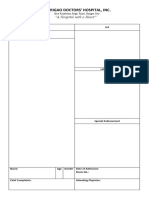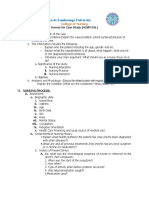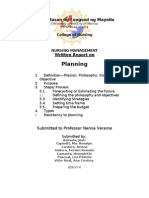0 ratings0% found this document useful (0 votes)
237 viewsEthics Case Study
Ethics Case Study
Uploaded by
casscactus1) A patient presented with a fall onto their arm and a query of a wrist fracture. They were asleep in the radiology department for an x-ray examination.
2) The radiographer encountered the patient asleep and had to wake them, which caused the patient to become agitated due to their dementia.
3) Informed consent could not be fully obtained due to the patient's state, raising ethical issues of autonomy and potential harm. The radiographer had to decide whether to proceed with the examination.
Copyright:
© All Rights Reserved
Available Formats
Download as DOCX, PDF, TXT or read online from Scribd
Ethics Case Study
Ethics Case Study
Uploaded by
casscactus0 ratings0% found this document useful (0 votes)
237 views4 pages1) A patient presented with a fall onto their arm and a query of a wrist fracture. They were asleep in the radiology department for an x-ray examination.
2) The radiographer encountered the patient asleep and had to wake them, which caused the patient to become agitated due to their dementia.
3) Informed consent could not be fully obtained due to the patient's state, raising ethical issues of autonomy and potential harm. The radiographer had to decide whether to proceed with the examination.
Original Description:
case study during placemnt
Copyright
© © All Rights Reserved
Available Formats
DOCX, PDF, TXT or read online from Scribd
Share this document
Did you find this document useful?
Is this content inappropriate?
1) A patient presented with a fall onto their arm and a query of a wrist fracture. They were asleep in the radiology department for an x-ray examination.
2) The radiographer encountered the patient asleep and had to wake them, which caused the patient to become agitated due to their dementia.
3) Informed consent could not be fully obtained due to the patient's state, raising ethical issues of autonomy and potential harm. The radiographer had to decide whether to proceed with the examination.
Copyright:
© All Rights Reserved
Available Formats
Download as DOCX, PDF, TXT or read online from Scribd
Download as docx, pdf, or txt
0 ratings0% found this document useful (0 votes)
237 views4 pagesEthics Case Study
Ethics Case Study
Uploaded by
casscactus1) A patient presented with a fall onto their arm and a query of a wrist fracture. They were asleep in the radiology department for an x-ray examination.
2) The radiographer encountered the patient asleep and had to wake them, which caused the patient to become agitated due to their dementia.
3) Informed consent could not be fully obtained due to the patient's state, raising ethical issues of autonomy and potential harm. The radiographer had to decide whether to proceed with the examination.
Copyright:
© All Rights Reserved
Available Formats
Download as DOCX, PDF, TXT or read online from Scribd
Download as docx, pdf, or txt
You are on page 1of 4
Cassandra Louise Vu 311206794
MRTY3106 Clinical Education 3DR
Ethics case study report
Clinical history
Patient A, an in patient presented remaining asleep in a hospital bed situated at the
bed bay of the radiology department. The clinical history stated that Patient A had a
fall onto arm, querying fracture and request form indicated that an x-ray of Patient As
right wrist with all standard views AP, oblique and lateral to be performed. The x-rays
requested deemed medically justifiable because it was directly relevant to the clinical
history stated and the area of concern on the patients body.
As Patient A was a current in-patient at the hospital, we viewed the hospital notes to
retrieve any further valuable information of the patients current state. The hospital
notes outlined that Patient A has dementia and said that she was cooperative and
responsive.
Informed consent
Informed consent is directly related to the ethical concern for client autonomy. It is
the responsibility of the health care worker to provide information disclosure to the
patient so that a decision can be deduced on whether to proceed with the x-ray
procedure. It is important that the patient understands the key issues of the
procedure and before the examination; patient must have made an informed and
voluntary decision to proceed. It is also necessary to respect the patients individual
choices. A respect for autonomy presupposes a sense of beneficence. (Loewy,
1996)
Before patient A arrives to the x-ray department bed bay, consent should have
already been sought through a communicating doctor. Radiographer went to the bed
bay to introduce himself and to take the patient for their examination but found that
patient A was asleep. The radiographer checked the patients wristband for
identification. Before commencing the x-ray examination, a verbal routine check of
the patients identity and birthdate was needed but it was not possible to confirm
when the patient was asleep and unconscious. It was therefore necessary to wake
Patient A, especially as she was a dementia patient to introduce themselves as a
radiographer and further reiterate that they will be taken into an x-ray room for the
examination to commence, this was also to confirm their informed consent. The
radiographer proceeded to wake Patient A verbally with exceptional volume in his
voice. Patient A awoke angry and confused as the radiographer then introduced
himself and clarified that she will be taken into another room for her x-ray
examination. The patient was still in a daze and the radiographer repeated his words.
Patient A complained of the volume and insisted the radiographer to stop yelling at
her. Radiographer took her into the examination room already set up and further
confirm that the clinical history was met with the patient by asking which wrist was
affected by the injury and how long ago the injury took place. Patient A became very
agitated but was responsive she further complained of the rudeness of the staff that
she was met with. The patient was non-compliant during the examination, and would
not keep her right arm still for the exam when asked to do so.
Cassandra Louise Vu 311206794
Ethical dilemma
The radiographers encountered resistance even though it was clear the patient heard
and understood what needed to be performed. The patient was initially noncompliant and would not keep her right arm still for the exam when asked to do so. It
was clear that Patient A was reluctant to begin the examination. The hospital notes
mentioned patient was present with dementia including that she was cooperative and
responsive.
The radiographers involved were challenged with the principles of autonomy and
non-maleficence. A negative relationship between the radiographer and the patient
had been established. Patient A displayed signs of agitation and reluctance,
furthermore, informed consent could not be sufficiently obtained. This lack of consent
challenges the principle of autonomy, which leaves the radiographer to decide
whether or not he should fulfil the request sent by the general practitioner. The
current standards on informed consent generated by the Australian NHMRC
guidelines state that patients are entitled to make their own decisions and that in
order to do so, they must have enough information about their condition, options for
investigation and treatment, benefits of treatment, possible adverse effects of
treatment or investigation, likely results if treatment is not undertaken, time and cost
of treatment. (Berglund, 1998) Another challenging issue arises, how is autonomy
maintained for the patient with dementia? According to the Alzheimers association
(2011), autonomy is handled by an assessment of the individuals competence and
capacity to understand the consequences of a task and the alternatives that can be
chosen in relation to their individual values and beliefs. Allowing the person with
Alzheimers disease to feel that his or her autonomy is being respected is ethically
important. (2011)
Handling of ethical dilemma
The involving radiographer quickly picked up on the patients state of mind and
calmly communicated to the patient why the examination was going to be performed
and how long the procedure would take. The radiographer was obligated to protect
the patient from harmful consequences and also to respect the dementia patients
decisions and choices, taking into account that the hospital notes outlined that she
was responsive and therefore a competent individual in making decisions
(autonomy). In a sense, the radiographer acted towards the principle of beneficence
by trying to promote as much understanding of the nature of the procedure with an
explanation that the medical procedure would be valuable in providing adequate
diagnosis and determining required treatment. (Loewy, 1996) However, the
radiographer also recognised the importance of respecting the patients autonomy,
acting on behalf of the patients best interests. The patient agreed to continue further
but was still irritable. The radiographer apologised in interrupting her sleep earlier
and intended not to cause harm (non-maleficence), afterwards the patient was less
agitated and slightly more cooperative, allowing for positive communication to
progress.
The radiographer performed the examination as quick as possible as the patient
would not keep her right hand still and it was unnecessary to use restraints. An AP,
oblique and lateral of the right wrist was obtained with minimal distress.
The overall situation was handled well as the qualified radiographer acted rationally
and on behalf of the patients greater good and interests. The radiographer did not
intend to cause harm when interrupting the patients sleep at the beginning, and this
was necessary to first gather informed consent. One improvement is that the
radiographer could have been less abrupt when speaking to the patient initially as
the patient had just woken up and slowly regaining consciousness of their
Cassandra Louise Vu 311206794
surroundings. It was well handled in that the radiographer took on an obligation in
promoting the benefit of the procedure in providing a diagnosis and an answer to the
query at hand. He was able to aid the patients understanding of the situation and
therefore legally perform the examination by obtaining true consent. The
radiographer upheld ethical and moral values through treating the dementia patient
just as any other patient with respect and respect of their choices with the intent to
cause no harm and aiming to perform with minimal distress to the patient.
(Alzheimers association, 2011)
Learning outcome
From this ethical dilemma, I have come to terms with the values of autonomy,
beneficence and non-maleficence and have recognised with clarity, the importance
of maintaining these ethical standards in the medical setting. I have learnt that
obtaining informed consent from the patient is significant in maintaining the patients
right to choice. Communication and the way radiographers communicate to patients
play a big role in maintaining positive practitioner-patient relationship to understand
the needs and interests of the patient with a degree of professionalism. Through this
situation, I can strive to achieve on working for the best interests of the patient
through improving on patient care and empathy. Ethical dilemmas will always be
encountered in the medical setting, and this situation has provided me with insight
into exercising a sense of autonomy, especially in maintaining autonomy for the
dementia patient, while also understanding to use minimal force if a patient is noncompliant in order to preserve the individuals dignity.
Cassandra Louise Vu 311206794
References
Alzheimers association. Respect for autonomy. Approved September 2011 from
http://www.alz.org/documents_custom/statements/respect_for_autonomy.pdf
American nurses association. Ethics definitions. From
http://www.nursingworld.org/MainMenuCategories/EthicsStandards/Resources/Ethic
s-Definitions.pdf
Berglund, C. (1998) Ethics for health care. Melbourne : Oxford University Press, Ch.
3.
Beauchamp, T. & Childress, J. (2001) Principles of Biomedical Ethics, 5th Ed, Oxford
University Press, Oxford.
Edge, R. (2006) Ethics of health care: a guide for clinical practice. 3rd ed. Clifton
Park, NY: Thomson Delmar Learning
Loewy, Erich H. Textbook of healthcare ethics / Erich H. Loewy. New York: Plenum
Press, c1996. Ch. 6.
You might also like
- Retrograde SaturnDocument6 pagesRetrograde SaturnDheeraj Kumar100% (1)
- Patients CharterDocument21 pagesPatients CharterEric MensahNo ratings yet
- Chapter 6 Nurse-Patient Relationship Theories 1Document31 pagesChapter 6 Nurse-Patient Relationship Theories 1api-308551668No ratings yet
- The COAT & Review Approach: How to recognise and manage unwell patientsFrom EverandThe COAT & Review Approach: How to recognise and manage unwell patientsRating: 5 out of 5 stars5/5 (1)
- Chapter 7 The Nurse-Client Relationship PDFDocument9 pagesChapter 7 The Nurse-Client Relationship PDFJa YaNo ratings yet
- Questions, Tfn.Document2 pagesQuestions, Tfn.Grace Panuelos OñateNo ratings yet
- The Importance of Evidence-Based Practice in NursingDocument9 pagesThe Importance of Evidence-Based Practice in Nursingapi-740215605No ratings yet
- 11 Core Competencies Part 1 To Part 2Document4 pages11 Core Competencies Part 1 To Part 2marie100% (2)
- Nursing Leadership Clinical Practicum JournalDocument5 pagesNursing Leadership Clinical Practicum JournalSandra JeffersonNo ratings yet
- Concepts A Middle Range TheoriesDocument2 pagesConcepts A Middle Range TheoriesLouwella RamosNo ratings yet
- Patient Care Delivery SystemDocument4 pagesPatient Care Delivery SystemSheen aballeNo ratings yet
- Or RRLDocument4 pagesOr RRLAlponce Edal AdagNo ratings yet
- Task 1 Nursing Quality IndicatorsDocument9 pagesTask 1 Nursing Quality IndicatorsHogan ObiNo ratings yet
- Precede ProceedDocument5 pagesPrecede Proceedemmet11100% (3)
- Nursing Care Plan (NCP) : Date and Time Nursing Diagnosis Short - Term and Long - Term OutcomesDocument2 pagesNursing Care Plan (NCP) : Date and Time Nursing Diagnosis Short - Term and Long - Term OutcomesDeanne Carla DalilisNo ratings yet
- Do Not Resuscitate OrdersDocument10 pagesDo Not Resuscitate OrdersMishael Mokamad CasimNo ratings yet
- Triage and Priority SettingDocument10 pagesTriage and Priority SettingekonurcahyaningrumNo ratings yet
- Nicu Reflection FinalDocument1 pageNicu Reflection Finalapi-546925142No ratings yet
- CHN Health PromotionDocument7 pagesCHN Health PromotionNareeza AbdullaNo ratings yet
- Cognitive: Rational Thought or Thinking.: A. Professional PreparationDocument4 pagesCognitive: Rational Thought or Thinking.: A. Professional PreparationJenny TuraNo ratings yet
- N375 Critical Thinking Activity ExampleDocument6 pagesN375 Critical Thinking Activity ExamplefaizaNo ratings yet
- Sbar Simulation ReflectionDocument3 pagesSbar Simulation Reflectionapi-314635911100% (2)
- Prof Ad Day 1Document136 pagesProf Ad Day 1Kareen ArnaizNo ratings yet
- Health Assessment 1-50 QuestionnaireDocument36 pagesHealth Assessment 1-50 QuestionnairetflorenzNo ratings yet
- Change InitiativeDocument7 pagesChange InitiativeWajiha ShaikhNo ratings yet
- Case Study Hospital FormatDocument3 pagesCase Study Hospital Formatsenyorakath0% (1)
- Final ResearchDocument65 pagesFinal ResearchHarbrinder GurmNo ratings yet
- Film Analysis: in Health Care Ethics (NR-NUR127)Document5 pagesFilm Analysis: in Health Care Ethics (NR-NUR127)John MagtibayNo ratings yet
- Pulido, Nathaniel T. (Quiz - Activity 6)Document2 pagesPulido, Nathaniel T. (Quiz - Activity 6)Nathaniel PulidoNo ratings yet
- Reflective Writing 2Document4 pagesReflective Writing 2dileepkumar.duhs4817No ratings yet
- Medication ErrorDocument3 pagesMedication Errortonlorenzcajipo100% (1)
- NP Colon Cancer by 13-2Document9 pagesNP Colon Cancer by 13-2Melody Medina100% (1)
- Final Thesis With CV (For Bookbind)Document138 pagesFinal Thesis With CV (For Bookbind)Bea Marie Eclevia100% (1)
- NLM Module 7Document7 pagesNLM Module 7ACIO, STEPHANY G.No ratings yet
- Questionaire-Nursing ResearchDocument2 pagesQuestionaire-Nursing ResearchEJ Cubero, R☤NNo ratings yet
- N1R01A - Transes in Introduction To NursingDocument8 pagesN1R01A - Transes in Introduction To NursingMikhaella GwenckyNo ratings yet
- 2015 - Nursing Students' Experiences of and Satisfaction With The Clinical Learning EnvironmentDocument12 pages2015 - Nursing Students' Experiences of and Satisfaction With The Clinical Learning EnvironmentDaniel Andres Rincon AlvarezNo ratings yet
- Bed Alarms and Fall RiskDocument11 pagesBed Alarms and Fall Riskapi-253792021No ratings yet
- Ncmb418 Lec PrelimDocument16 pagesNcmb418 Lec Prelim11 - JEMELYN LOTERTENo ratings yet
- Unit-VII Professional Autonomy and EthicsDocument13 pagesUnit-VII Professional Autonomy and Ethicsofficialgaming655No ratings yet
- Lecture7 Qualityimpovement HealthmanagementDocument61 pagesLecture7 Qualityimpovement HealthmanagementFarah FarahNo ratings yet
- Project On Study The Extent of Self Medication.Document42 pagesProject On Study The Extent of Self Medication.keyur100% (1)
- Duties and Responsibilities of Scrub Nurse:: Before An OperationDocument7 pagesDuties and Responsibilities of Scrub Nurse:: Before An OperationMary Grace Relato BapialNo ratings yet
- Critical Reflection1Document6 pagesCritical Reflection1api-313097878No ratings yet
- Application of Ethical PrinciplesDocument3 pagesApplication of Ethical Principlesponce_0808No ratings yet
- CHNDocument34 pagesCHNCatherine RomeroNo ratings yet
- Cardex Nursing Endorsement SheetDocument1 pageCardex Nursing Endorsement SheetGerald TalledoNo ratings yet
- Atun Maricris Jorre Ca2 Au Legarda Leadership Managemet Research DownloadableDocument2 pagesAtun Maricris Jorre Ca2 Au Legarda Leadership Managemet Research DownloadableCharissa Magistrado De LeonNo ratings yet
- Assisting in IV TherapyDocument4 pagesAssisting in IV TherapyMaricris Dianne D BondocNo ratings yet
- Role of Research, Leadership and Management in Nursing: Mrs. Amrita Roy M.SC Psychiatric Nursing Nimhans, BangaloreDocument19 pagesRole of Research, Leadership and Management in Nursing: Mrs. Amrita Roy M.SC Psychiatric Nursing Nimhans, BangalorePrasann Roy100% (1)
- NCMB 419 Week 11 CU10Document23 pagesNCMB 419 Week 11 CU10GERALDINE GONZALESNo ratings yet
- Chapter - 021 Case StudyDocument2 pagesChapter - 021 Case Studydonnam86No ratings yet
- Nursing Care PlanDocument2 pagesNursing Care PlanMiar QuestNo ratings yet
- CM1, CU 1, WK 1-Introduction To Leadership and ManagementDocument16 pagesCM1, CU 1, WK 1-Introduction To Leadership and ManagementMichelle Gliselle Guinto MallareNo ratings yet
- 1 Surgical MemorandumDocument1 page1 Surgical MemorandumAina HaravataNo ratings yet
- SANC Competencies Emergency NurseDocument28 pagesSANC Competencies Emergency Nursemakabe.k02121127No ratings yet
- Case Study (HOSPITAL)Document4 pagesCase Study (HOSPITAL)Reyna Mee AhiyasNo ratings yet
- AU CA2 Course OutlineDocument4 pagesAU CA2 Course OutlineYaj Cruzada100% (1)
- Energy Field Theories Energy FieldsDocument12 pagesEnergy Field Theories Energy FieldsJames Kurt CruzatNo ratings yet
- Health Promotion ModelDocument2 pagesHealth Promotion ModelpatrickarvinNo ratings yet
- Nursiing Management WR. Whole PackageDocument24 pagesNursiing Management WR. Whole Packageeyna30No ratings yet
- Estudios Urbanisticos Literatura HispanoamericanaDocument223 pagesEstudios Urbanisticos Literatura HispanoamericanaCésar Andrés ParedesNo ratings yet
- People V MolinaDocument3 pagesPeople V MolinaJc IsidroNo ratings yet
- Qualitative Inquiry: Grounded Theory in Global Perspective: Reviews by International ResearchersDocument12 pagesQualitative Inquiry: Grounded Theory in Global Perspective: Reviews by International ResearchersenviNo ratings yet
- Interpretive Level of ComprehensionDocument6 pagesInterpretive Level of ComprehensionRhezan Bert DialinoNo ratings yet
- Messages From The Epistle To The Hebrews by Moule, Handley C.G.Document47 pagesMessages From The Epistle To The Hebrews by Moule, Handley C.G.Gutenberg.orgNo ratings yet
- Ashtanga Yoga I and II Complete OCR (Finereader - IsTA SettingsDocument192 pagesAshtanga Yoga I and II Complete OCR (Finereader - IsTA SettingsAndreea Bertea0% (1)
- TLWDocument134 pagesTLWps0208No ratings yet
- CQ Compatibility QuotientDocument11 pagesCQ Compatibility Quotientpanayot_arNo ratings yet
- Shame & GuiltDocument15 pagesShame & GuiltLu OrdóñezNo ratings yet
- Film As ArtDocument15 pagesFilm As ArtMadakari NayakaNo ratings yet
- Ethical Principles of Guidance and CounsellingDocument8 pagesEthical Principles of Guidance and CounsellingParimaladevi Sinniapan100% (4)
- PIL ASSIGNMENT FOR November 22Document2 pagesPIL ASSIGNMENT FOR November 22Ma. Yvone DavidNo ratings yet
- Man or Rabbit OGDocument3 pagesMan or Rabbit OGCalCorrentiNo ratings yet
- Coat of ArmsDocument2 pagesCoat of ArmsmartyNo ratings yet
- IronyDocument1 pageIronyDas EducationNo ratings yet
- 12th Reading Worksheet Unit 0Document1 page12th Reading Worksheet Unit 0Roughie L. PalmaNo ratings yet
- EM 208 - LeadershipDocument33 pagesEM 208 - LeadershipMichelle Copones LlanesNo ratings yet
- Descartes Handout The Rules and Maxims I PDFDocument1 pageDescartes Handout The Rules and Maxims I PDFAnonymous u80JzlozSDNo ratings yet
- Course Outline Intro To Philo With LogicDocument6 pagesCourse Outline Intro To Philo With LogicMichel NayreNo ratings yet
- Interference of Light Waves PDFDocument29 pagesInterference of Light Waves PDFSGNo ratings yet
- ArthockneyDocument2 pagesArthockneydaveorrittNo ratings yet
- Swajaldhara GuidelinesDocument9 pagesSwajaldhara GuidelinesSridhar AnanthaNo ratings yet
- Latin MaximsDocument1 pageLatin MaximsMaria CarmelaNo ratings yet
- Wayana, A Grammar of (Da Silva)Document454 pagesWayana, A Grammar of (Da Silva)Rydzek MapperNo ratings yet
- Michael Spitzer Tovey's Evolutionary Metaphors PDFDocument33 pagesMichael Spitzer Tovey's Evolutionary Metaphors PDFgonzalovillegas1987100% (1)
- Algebra ReportDocument3 pagesAlgebra ReportArianne CalabiaNo ratings yet
- Two Week Takeover WebsiteDocument11 pagesTwo Week Takeover Websiteapi-192946704No ratings yet
- 4-Philo History PDFDocument74 pages4-Philo History PDFJ PiNo ratings yet
- 1 PDFDocument14 pages1 PDFMauricio AnayaNo ratings yet

























































































